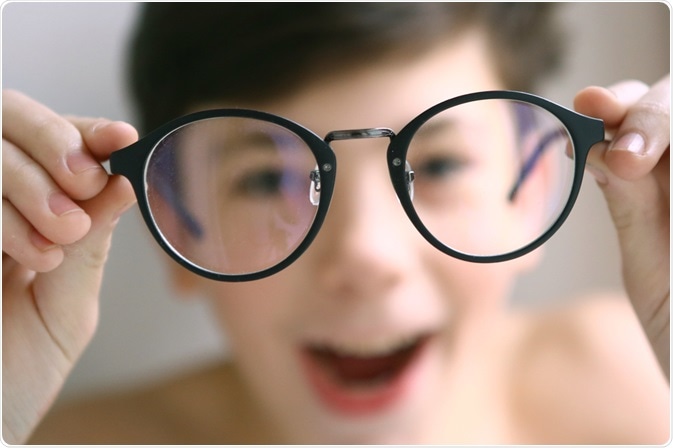Myopia represents the most common cause of vision impairment worldwide, and many attempts have been made with spectacles, rigid lenses, therapeutics, and other techniques to control its progression in children and young adults.

Image Credit: Lapina / Shutterstock.com
Causes
The surge in prevalence seems to be associated with increasing educational pressures, combined with lifestyle changes, which have reduced the time that children spend outdoors.
In spite of a long history of study, as well as a noteworthy increase in research attention, the means of preventing the progression of myopia are still elusive. Environmental factors can influence the prevalence of myopia, which has been shown with intensive visual near work such as reading, writing, and close work at the computer.
Hence, visual hygiene measures are often recommended, which include taking a break every 30 minutes when doing intensive near work, maintaining proper distance from the book while reading, keeping sufficient illumination, doing visual work using a relaxed upright posture, and placing a limit on the time spent watching the television.
Are Humans Slowly Losing Their Eyesight? | The Nearsightedness Epidemic
Outdoor activities as a preventive measure
Recent epidemiological research points to the fact that children who spend more time outdoors are less prone to the development of myopia, regardless of their eventual genetic burden or how much near work they do. At the moment, it is still uncertain if time outdoors can also halt the progression of the condition.
The suggested mechanism of the protective effect of outdoor activities involves the light-stimulated release of the neurotransmitter dopamine from the retina. This is believed to be due to increased dopamine levels that inhibit further axial elongation, which is the pathophysiological basis of myopia.
Experiments on animals have supported this hypothesis since the protective effects of bright light against the development of myopia have been replicated under laboratory conditions. Furthermore, it has been proven that the effect is, at least partially, mediated by dopamine, considering that the D2-dopamine antagonist spiperone reduces this protective effect.
Although certain inconsistencies are noted in the evidence, particularly limited inhibition by the bright light of lens-induced myopia in laboratory monkeys, other mechanisms can also contribute to the reduced development of myopia when spending time outdoors. For example, increased physical activity, relaxed accommodation, increased pupil constriction, more uniform dioptric space, exposure to ultraviolet light, and changes in the spectral composition of visible light are all believed to protect individuals against myopia.
Clinical trials are now underway hoping to halt or reduce the development of myopia in children by increasing the amount of time they spend outside. A more precise definition of the thresholds for protection in terms of duration and intensity of light exposures is needed. Epidemiological studies are undoubtedly helpful, but questionnaires should be replaced with more precise measurements of exposures.
Controversial eye-exercises
The controversial Bates eye method is an alternative therapy that can supposedly prevent and cure myopia and other refractive diseases of the eye with the use of specific exercises. The method is based on the work and theories of William Horatio Bates, who was a medical doctor and eye specialist practicing in the late 19th and early 20th centuries.
Bates claimed that the physiological characteristics of the eye are not responsible for the development of myopia, but the condition rather arises as a result of a combination of strain and incorrect habits of visual information processing. Hence, central fixation, palming, visualization, swinging, shifting, and sunning should significantly aid in the prevention of this condition.
Nevertheless, the principles behind the Bates technique vary greatly from the conventional understanding of myopia. In addition, anecdotal reports of vision preservation and improvement have not been fully evaluated in trials. There is no clear scientific data published in the mainstream literature supporting the use of eye exercises to improve visual acuity; therefore, their use remains controversial.
It is important to note that there is no scientific evidence that any of the commercial devices for myopia treatment can truly prevent, reduce, or retard the progression of myopia. Adequate scientific studies are therefore necessary for any treatment modality or product prior to making unsubstantiated claims of myopia prevention.
References
Further Reading